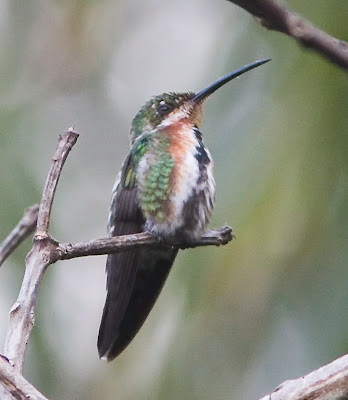Mango at Miguel de la Borda, a report by Rosabel Miró
Last weekend, a small group of brave Panama Auduboners headed on an exploratory trip to Miguel de La Borda and the recently-declared Donoso Protected Area.
¿Any guesses? It's probably pointless looking at the immatures, so it all comes down to looking for black on the throat of the male. I think i don't see any, but it's late and I'm tired.
El viernes en la tarde, en los alrededores del pueblo, como a eso de las 4 pm nos encontramos con varios Veraguan [?—see below] Mangos (no menos de 4 manchos, 1 hembra). Les adjuntamos fotos de los colibríes.The literature on Veraguan/Green-breasted Mango fieldmarks is a mess. Wetmore (1968), when describing what is now Veraguan Mango, lays down the rules:
El sábado en la mañana, como a eso de las 8:00am, en el Río Miguel de la Borda nos encontramos con varias decenas de Turkey Vultures migratorios que, al parecer, pasaron la noche en los potreros aledaños al río. Te adjuntamos una foto también. Adicional, nos tocó observar el viernes, sábado y domingo grupos pequeños de vultures migrando. Esa misma mañana, el el sendero de Quebrada El Caño, a diez minutos del pueblito de Guásimo (a orillas del río Miguel de La Borda) nos encontramos con un pequeño bosque de heliconias donde observamos a un Bronze-tailed Plumeleteer posado. Más arriba, en el mismo sendero observamos unos 3-5 Plumbeous Kites en el área y vimos uno que se posó en un árbol de Bongo (una ceiba). Cuando observamos con atención pudimos observar que tenía un palito en el pico que colocó en el nido donde se posó por más de 5 minutos que duró nuestra observación a él. Te adjuntamos la foto también, como otro record más de que esta ave anida en el Caribe panameño.
En esta gira estaban Venicio Wilson, Karl Kaufmann, Claudia y Bill Ahrens, Katia Weitendorf y Rosabel Miró.
- Male all green on the breast, although some have a little black in the center of the throat; maroon tail feathers
- Female all white underneath with a green stripe down the middle; tail with a blue-black terminal band and white tips
- Immature like female, but have the white underparts bordered in rufous, with the central stripe blacker in males; "under tail coverts with a a narrow subterminal band of dull rufous at the end"
- Adult Veraguan male and female as in Wetmore
- Immature Veraguan like female but with underparts adjacent to median stripe rufous
- Male Green-breasted has narrow stripe of black down center of throat, sharply demarcated from green on sides, extending down to upper chest, where it blends with dark bluish on sides
- Female Green-breasted has rufous on lower face and sides of breast
- Immature Green-breasted not described
- Male Green-breasted as in Ridgeley
- Female Green-breasted like female Veraguan on Wetmore (i.e. no rufous below)
- Juvenile like immature Veraguan on Wetmore (i.e. rufous on outer sides of white underparts, not adjacent to middle stripe)
- Male Veraguan Mango as in Ridgeley and Wetmore
- Female and juvenile Veraguan Mango not described
¿Any guesses? It's probably pointless looking at the immatures, so it all comes down to looking for black on the throat of the male. I think i don't see any, but it's late and I'm tired.



